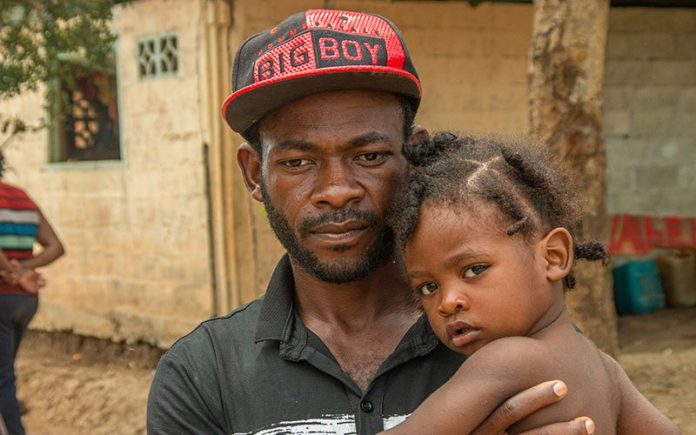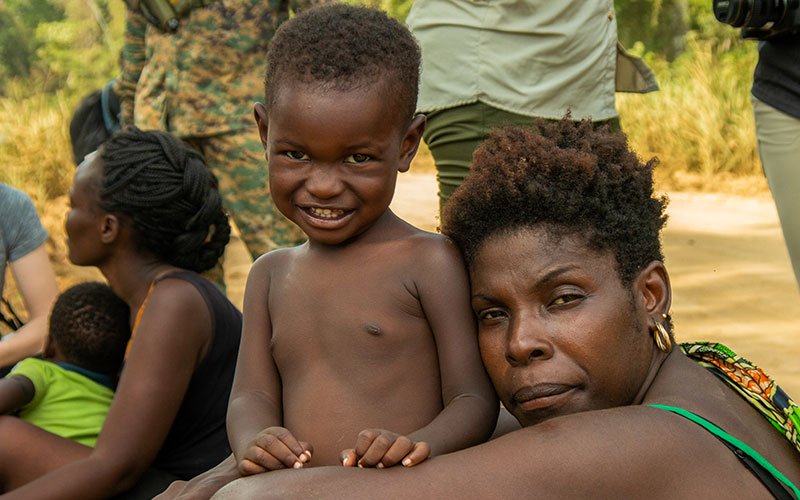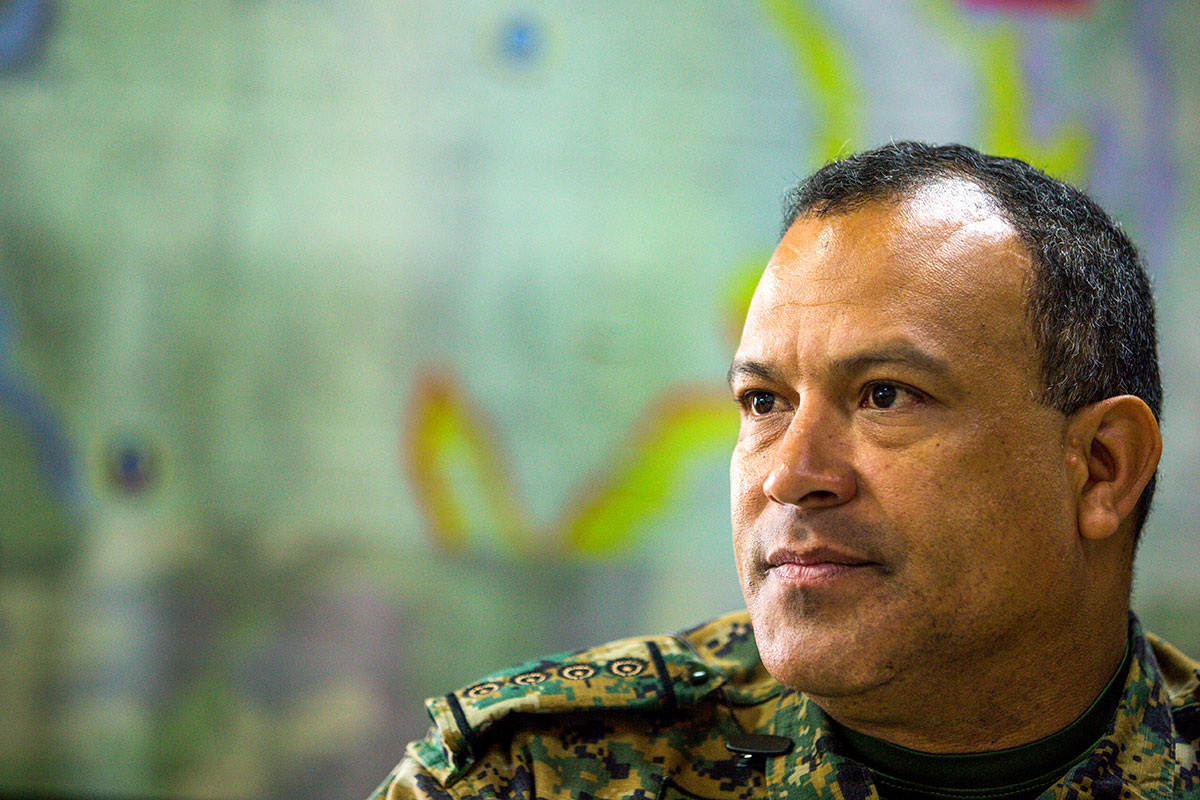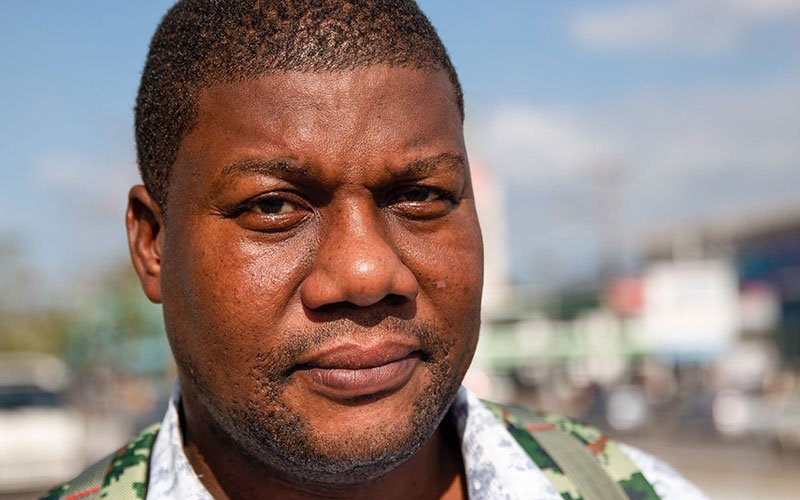
In 2018, Haïti Liberté sent a journalist to Colombia to investigate the migration of Haitians from South America into Central America on their way to the U.S.. Most Haitians were coming from Brazil, Ecuador, and Chile, whose economies were contracting as right-wing leaders took control.
Haitians make their way up the Pan-American Highway, which effectively ends in South America in the northwestern Colombian town of Turbo. From there, Haitian migrants voyage about 56 miles, often in unsafe boats, across the Bay of Urabá to the town of Capurgana, the northernmost settlement in a remote, isolated finger of Colombian coastline territory which one resident said is “as dangerous as the Wild West.”
Still, the most trying part of the Haitians’ trek lies before them. Most people don’t realize that not a single road connects Colombia to its neighbor, Panama, which was amputated from Colombia (with Washington’s encouragement) in the late 19th and early 20th centuries.
The two nations are divided by a forbidding jungle known as the Darién Gap. Haitians, and other migrants, make their way through this rugged wilderness on paths, sometimes guided by sometimes unscrupulous guides known as “coyotes.” Often they are ambushed, robbed, and, on occasion, even raped or killed.
The passage through the Darién Gap’s rainforest takes about a week: two days to reach the Panamanian border and then another five days to reach the first border town.
The following account explains the perils of this passage as well as the uncertainty and challenges which face Haitians who succeed in making it to Central America.
Kim Ives
LA PEÑITA, Panama – Nicole Elizabeth tightly hugs her 2-year-old son, David, after hours of walking in flip-flops in searing heat as her family tries to reach this indigenous village, where Panama’s border patrol has an outpost.
The Haitian woman uses hand gestures to indicate they were robbed in the treacherous jungle of the Darién Gap, which straddles Panama’s border with Colombia. Elizabeth puts two fingers to her right temple, imitating a gun.
“Muito dificil,” she whispered in broken Portugese, a language she likely picked up while living in Brazil. “Very difficult.”

Despite the dangers of the jungle, increasing numbers of Haitian nationals are risking the journey to leave their Caribbean island homeland, which is the poorest in the Western Hemisphere, according to the World Bank. Panamanian officials say Haitians have far outnumbered migrants from other countries in the first three months of 2020.
Haitians made up 72.5% of the migrants detained after illegally crossing the jungle into Panama in January, February and March, according to Panama’s National Migration Service. Haitians apprehended crossing the Darién jungle skyrocketed from 31 in 2017 to more than 10,000 in 2019. Most have their sights set on the United States.
And the number of Haitian migrants continues to grow, said Oriel Ortega Benitez, the director general of SENAFRONT, Panama’s border patrol.
Many of the Haitians started their journeys thousands of miles away, in such South American countries as Brazil or Chile, which had attracted Haitian migrants with the prospect of jobs.
Although undocumented, the Haitians openly lived and worked in those countries for years, until jobs dried up and officials began cracking down. Chile, for example, changed its visa policy in 2018 so that every Haitian migrant must obtain a tourist visa from a Chilean consulate in Port-au-Prince. The visa lasts for 30 days and can’t be exchanged for work permit or temporary residence.
The change affected Marckenson Lebrun and his wife. Desperate to escape a poor quality of life in Haiti, they moved to Chile four years ago. But as the economic and political situation in Chile worsened, they made plans to go to the United States.
That’s when Lebrun discovered the route through Darién from a WhatsApp chat for Haitian nationals. The family was part of a group of migrants who spent seven days in the jungle.
“You sleep, and in the middle of the night, you hear a lot of animals. You don’t know if the animals are coming to you,” Lebrun said.
Wild animals are not the only threat the jungle holds, he said, noting that he saw several bodies. And he knew one migrant who died of starvation. He recalled that people were robbed by gangs and lost all their belongings – money, clothes and passports – and arrived empty handed at Bajo Chiquito – one of the first migrant camps on the Panama side of the jungle.
Bajo Chiquito often is where migrants first encounter SENAFRONT, which provides humanitarian assistance but also places the migrants into Panama’s “controlled flow” system, which moves them north from camp to camp until they reach Costa Rica. Before moving them along, SENAFRONT collects personal and biometric data, which is shared with U.S. immigration authorities.
“When they come here, they come with nothing,” Lebrun said as he stood in the camp.
Alexis Betancourt, Panama’s former minister of security who now works on the frontlines as a top commander for SENAFRONT, said migrants do not know whether they have been robbed in Colombia or Panama because the jungle is so vast – 60 miles across at many points. Many migrants discard their passports during the journey north to avoid deportation later, he said, arriving in Panama without money, cell phone, or identification.

Natalie Dorcame, a Haitian migrant who lived in Chile for three years, was part of a group that traveled the Darién and fell victim to bandits.
“They have robbed us all the money we had, even food. One of my companions was robbed of a passport,” said Dorcame, whose two sons, mother and brothers remain in Haiti.
Caitlyn Yates, research coordinator at Institute for National Strategic Studies in the U.S., has interviewed many migrants as they emerged from the jungle. She said that in addition to violence and assault, the rugged, remote, dangerous terrain makes it hard to get out alive.
“They have never been in the region or they don’t know how to swim, and they share a lot of stories about folks drowning or getting swept away,” Yates said, adding that many she has interviewed remember “seeing dead bodies along the trail.”
There is a lack of information about what to expect on the journey, Yates said, and many migrants who start are ill-prepared and regret coming.
“Everyone kind of says the same thing, ‘We didn’t know, I would not have done it if I had known.’”
In Bajo Chiquito, migrants live mostly in abandoned houses and tents. Their numbers have overwhelmed Panamanian officials, leading to the lack of food and drinking water and sanitation problems. The country, which already has problems meeting the health care needs of rural Panamanians, has not been able to provide permanent medical care for migrants at the camp.
“The life right here is too much,” Lebrun said of his time in Bajo Chiquito, where he had spent eight days. “When you pass in the jungle, there are a lot of difficult things. When you come here, you don’t have a doctor to check your health.”
Living in Bajo Chiquito is especially difficult for migrants who have young children. Gupsson Joseph, his wife and their son left Haiti because of political and economic problems and lived in Chile for three years. He said his son had a fever and diarrhea because the family had no money, and they had been drinking the water from the river, as did many other migrants in the camp.
SENAFRONT says it moves migrants through the camps on a regular schedule based on when they arrived. A typical stay in Bajo Chiquito is eight to 12 days, according to the border agency. After that, migrants have two options: pay $25 to indigenous villagers to take them by boat to the next camp on the route, La Peñita, or walk six hours along a dirt road through the jungle, usually in hot, humid weather.
Elizabeth, the Haitian mother, didn’t wait for the boat. She took her children, David and Lopish, and walked from Bajo Chiquito to La Peñita.
Before striking out for the U.S. more than a month earlier, Elizabeth had lived in Brazil for four years; she left because the socioeconomic “situation was really bad.” The family spent 10 days in Bajo Chiquito before walking to La Peñita, where migrants wait to be driven by bus to the Costa Rican border.
3,239 Haitian migrants were involved in a controlled flow from January to March 2020
This is all a part of Panama’s controlled flow policy, which is a joint program between Panama and Costa Rica – cooperating with the United States – that includes transportation of migrants through the country, as well as data collection and sharing.
Based on data from Panama’s National Migration Service, 3,239 Haitian migrants were involved in a controlled flow from January to March 2020, along with 109 Cubans and 453 “extracontinentals” – migrants who come from outside the Western Hemisphere.
SENAFRONT and the Migration Policy Institute point to the socioeconomic crisis in Haiti as the major factor driving the mass migration. According to a 2017 report by the institute, after a devastating 2010 earthquake that killed tens of thousands of people and displaced 1.5 million, many Haitians fled to Brazil, which at the time was preparing for the 2016 Summer Olympics and had relaxed its visa requirements in part to attract migrant labor.
“But amid economic and political turmoil there in the last several years,” the report said, “many have moved on to destinations, including Chile and the United States.”
Chile’s thriving economy at the time also held promise for Haitians after the earthquake, said Santiago Paz, Panama chief of mission for the International Organization for Migration.
In the past nine years, Chile issued visas for 253,033 Haitians; 36% of them women. The majority have been living in the metro area of Santiago.
For years, Haitians could enter Chile as tourists and later apply for temporary residence or work permits. But in April 2018, President Sebastián Piñera’s government implemented an immigration reform introducing new visas for migrants of different nationalities, including Haitians and Venezuelans. Because of a new policy, to enter Chile, Haitians have to obtain a tourist visa that lasts for only 30 days and does not allow them to work.
“These changes in Chilean migratory policy were devised to find a solution to the wave of undocumented foreigners arriving in Chile over the last five years,” International Organization for Migration said in a news release in August 2018.
Family Reunification visas also were established for those Haitian nationals that legally reside in Chile to bring their family members.
As part of Piñera’s policy, Haitians who could not afford a journey back home would be offered free flights, but they had to sign a declaration not to come back to Chile for nine years. These flights were labeled as “humanitarian” by the government, but some migrant and advocacy groups considered them forced deportations.
From 2018 to 2019, the number of visas Chile granted to Haitians decreased by more than 29%. The number of Haitians residing in Chile fell as well, according to the Ministry of the Interior and Public Security.
Ortega, director general of SENAFRONT, said the change in Chile’s visa policy is one of the reasons so many Haitian migrants are risking the Darién and passing through Panama.
Panama had seen the influx of Haitian migrants since 2016, when the country signed the controlled flow agreement. The numbers rose from just seven to more than 16,000 in a year. Former Panamanian President Carlos Valera highlighted the crisis in a speech 2016 at the United Nations, noting that Haitian migrants were risking and losing their lives for “the hope of a better future” in the north.
The number of Haitian migrants in Panama decreased from 2017 to 2018 but increased again in 2019.

For most Haitian migrants, Panama primarily is a way-stop on the journey to Mexico and the U.S..
Lidia Gonzalez, a director at the Pastoral Social Caritas temporary shelter in Panama City, said about 600 families have come through since the center opened years ago and only eight were from Haiti.
“Their dream is the United States,” she said, adding that Haitians find it difficult to get a work permit and find a stable job in Panama.
But some still come to Panama to stay. Rather than risk transversing Darién, these migrants entered Panama by plane on a tourist visa.
Valintin Guyteau, 39, has been living in Panama City for more than three years. He left Haiti for personal security reasons, arrived on a tourist visa and later obtained a work permit. His mother, 6-year old son and other family members remain in Haiti.
“Without my family, I don’t feel good,” Guyteau said. “With my mom, it’s better. Every 24th of December, Christmastime, I remember my family, still remember. But I am alone in Panama. I have nothing.”
Guyteau worked in a call center for more than a year but now is jobless. He said many companies won’t hire him because of his nationality.
“They do not want a stranger,” Guyteau said.
For now, his main wish is to get a U.S. tourist visa and see his older son, who’s living in the United States, but his visa applications have been unsuccessful so far.
Guyteau’s overall plan is to find a job that pays well. This time, he hopes it will be in Mexico, which he believes will be an easier place to settle than the United States.
Paz, the Panama chief of mission for the International Organization for Migration, said the search for a better life – anywhere – is a constant in the lives of migrants.
“And many, most of them are looking for what we call the American dream,” he said.
Cronkite Borderlands Project is a multimedia reporting program in which students cover human rights, immigration, and border issues in the U.S. and abroad in both English and Spanish. This article was first published on the Cronkite News website.









